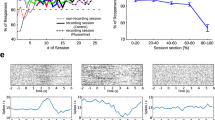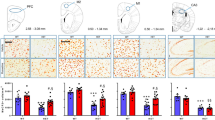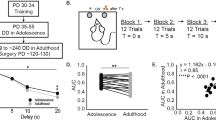Abstract
Relapse vulnerability in cocaine dependence is rooted in genetic and environmental determinants, and propelled by both impulsivity and the responsivity to cocaine-linked cues (‘cue reactivity’). The serotonin (5-hydroxytryptamine, 5-HT) 5-HT2C receptor (5-HT2CR) within the medial prefrontal cortex (mPFC) is uniquely poised to serve as a strategic nexus to mechanistically control these behaviors. The 5-HT2CR functional capacity is regulated by a number of factors including availability of active membrane receptor pools, the composition of the 5-HT2CR macromolecular protein complex, and editing of the 5-HT2CR pre-mRNA. The one-choice serial reaction time (1-CSRT) task was used to identify impulsive action phenotypes in an outbred rat population before cocaine self-administration and assessment of cue reactivity in the form of lever presses reinforced by the cocaine-associated discrete cue complex during forced abstinence. The 1-CSRT task reliably and reproducibly identified high impulsive (HI) and low impulsive (LI) action phenotypes; HI action predicted high cue reactivity. Lower cortical 5-HT2CR membrane protein levels concomitant with higher levels of 5-HT2CR:postsynaptic density 95 complex distinguished HI rats from LI rats. The frequency of edited 5-HT2CR mRNA variants was elevated with the prediction that the protein population in HI rats favors those isoforms linked to reduced signaling capacity. Genetic loss of the mPFC 5-HT2CR induced aggregate impulsive action/cue reactivity, suggesting that depressed cortical 5-HT2CR tone confers vulnerability to these interlocked behaviors. Thus, impulsive action and cue reactivity appear to neuromechanistically overlap in rodents, with the 5-HT2CR functional status acting as a neural rheostat to regulate, in part, the intersection between these vulnerability behaviors.
Similar content being viewed by others
Log in or create a free account to read this content
Gain free access to this article, as well as selected content from this journal and more on nature.com
or
References
Abbas AI, Yadav PN, Yao WD, Arbuckle MI, Grant SG, Caron MG et al (2009). PSD-95 is essential for hallucinogen and atypical antipsychotic drug actions at serotonin receptors. J Neurosci 29: 7124–7136.
Anastasio NC, Gilbertson SR, Bubar MJ, Agarkov A, Stutz SJ, Jeng YJ et al (2013a). Peptide inhibitors disrupt the serotonin 5-HT2C receptor interaction with phosphatase and tensin homolog to allosterically modulate cellular signaling and behavior. J Neurosci 33: 1615–1630.
Anastasio NC, Lanfranco MF, Bubar MJ, Seitz PK, Stutz SJ, McGinnis AG et al (2010). Serotonin 5-HT(2C) receptor protein expression is enriched in synaptosomal and post-synaptic compartments of rat cortex. J Neurochem 113: 1504–1515.
Anastasio NC, Stoffel EC, Fox RG, Bubar MJ, Rice KC, Moeller FG et al (2011). Serotonin (5-hydroxytryptamine) 5-HT2A receptor: Association with inherent and cocaine-evoked behavioral disinhibition in rats. Behav Pharmacol 22: 248–261.
Becamel C, Alonso G, Galeotti N, Demey E, Jouin P, Ullmer C et al (2002). Synaptic multiprotein complexes associated with 5-HT(2C) receptors: a proteomic approach. EMBO J 21: 2332–2342.
Belin D, Mar AC, Dalley JW, Robbins TW, Everitt BJ (2008). High impulsivity predicts the switch to compulsive cocaine-taking. Science 320: 1352–1355.
Bentley DR, Balasubramanian S, Swerdlow HP, Smith GP, Milton J, Brown CG et al (2008). Accurate whole human genome sequencing using reversible terminator chemistry. Nature 456: 53–59.
Besson M, Pelloux Y, Dilleen R, Theobald DE, Lyon A, Belin-Rauscent A et al (2013). Cocaine modulation of frontostriatal expression of Zif268, D2, and 5-HT2c receptors in high and low impulsive rats. Neuropsychopharmacology 38: 1963–1973.
Bradberry CW, Rubino SR (2004). Phasic alterations in dopamine and serotonin release in striatum and prefrontal cortex in response to cocaine predictive cues in behaving rhesus macaques. Neuropsychopharmacology 29: 676–685.
Breukel AI, Besselsen E, Ghijsen WE (1997). Synaptosomes. A model system to study release of multiple classes of neurotransmitters. Methods Mol Biol 72: 33–47.
Bubar MJ, Stutz SJ, Cunningham KA (2011). 5-HT(2C) receptors localize to dopamine and GABA neurons in the rat mesoaccumbens pathway. PLoS ONE 6: e20508.
Burns CM, Chu H, Rueter SM, Hutchinson LK, Canton H, Sanders-Bush E et al (1997). Regulation of serotonin-2C receptor G-protein coupling by RNA editing. Nature 387: 303–308.
Carpenter KM, Schreiber E, Church S, McDowell D (2006). Drug Stroop performance: relationships with primary substance of use and treatment outcome in a drug-dependent outpatient sample. Addict Behav 31: 174–181.
Carter BL, Tiffany ST (1999). Cue-reactivity and the future of addiction research. Addiction 94: 349–351.
Chen BT, Yau HJ, Hatch C, Kusumoto-Yoshida I, Cho SL, Hopf FW et al (2013). Rescuing cocaine-induced prefrontal cortex hypoactivity prevents compulsive cocaine seeking. Nature 496: 359–362.
Cunningham KA, Anastasio NC (2013). Serotonin at the nexus of impulsivity and cue ceactivity in cocaine addiction. Neuropharmacology (In press).
Cunningham KA, Anastasio NC, Fox RG, Stutz SJ, Bubar MJ, Swinford SE et al (2012). Synergism between a serotonin 5-HT2A receptor (5-HT2AR) antagonist and 5-HT2CR agonist suggests new pharmacotherapeutics for cocaine addiction. ACS Chemical Neuroscience 4: 110–121.
Cunningham KA, Fox RG, Anastasio NC, Bubar MJ, Stutz SJ, Moeller FG et al (2011). Selective serotonin 5-HT2C receptor activation suppresses the reinforcing efficacy of cocaine and sucrose but differentially affects the incentive-salience value of cocaine- vs. sucrose-associated cues. Neuropharmacology 61: 513–523.
Dalley JW, Everitt BJ, Robbins TW (2011). Impulsivity, compulsivity, and top-down cognitive control. Neuron 69: 680–694.
Dalley JW, Fryer TD, Brichard L, Robinson ES, Theobald DE, Laane K et al (2007). Nucleus accumbens D2/3 receptors predict trait impulsivity and cocaine reinforcement. Science 315: 1267–1270.
Dalley JW, Theobald DE, Eagle DM, Passetti F, Robbins TW (2002). Deficits in impulse control associated with tonically-elevated serotonergic function in rat prefrontal cortex. Neuropsychopharmacology 26: 716–728.
Daly TM (2004). Overview of adeno-associated viral vectors. Methods Mol Biol 246: 157–165.
Economidou D, Pelloux Y, Robbins TW, Dalley JW, Everitt BJ (2009). High impulsivity predicts relapse to cocaine-seeking after punishment-induced abstinence. Biol Psychiatry 65: 851–856.
Field M, Cox WM (2008). Attentional bias in addictive behaviors: a review of its development, causes, and consequences. Drug Alcohol Depend 97: 1–20.
Fletcher PJ, Rizos Z, Noble K, Higgins GA (2011). Impulsive action induced by amphetamine, cocaine and MK801 is reduced by 5-HT(2C) receptor stimulation and 5-HT(2A) receptor blockade. Neuropharmacology 61: 468–477.
Fletcher PJ, Rizos Z, Sinyard J, Tampakeras M, Higgins GA (2008). The 5-HT(2C) receptor agonist RO 60-0175 reduces cocaine self-administration and reinstatement induced by the stressor yohimbine and contextual cues. Neuropsychopharmacology 33: 1402–1412.
Frijda NH (2010). Impulsive action and motivation. Biol Psychol 84: 570–579.
Gavarini S, Becamel C, Altier C, Lory P, Poncet J, Wijnholds J et al (2006). Opposite effects of PSD-95 and MPP3 PDZ proteins on serotonin 5-hydroxytryptamine2C receptor desensitization and membrane stability. Mol Biol Cell 17: 4619–4631.
Green CE, Moeller FG, Schmitz JM, Lucke JF, Lane SD, Swann AC et al (2009). Evaluation of heterogeneity in pharmacotherapy trials for drug dependence: a Bayesian approach. Am J Drug Alcohol Abuse 35: 95–102.
Grottick AJ, Corrigall WA, Higgins GA (2001). Activation of 5-HT2C receptors reduces the locomotor and rewarding effects of nicotine. Psychopharmacology 157: 292–298.
Herrick-Davis K, Grinde E, Niswender CM (1999). Serotonin 5-HT2C receptor RNA editing alters receptor basal activity: implications for serotonergic signal transduction. J Neurochem 73: 1711–1717.
Hommel JD, Sears RM, Georgescu D, Simmons DL, DiLeone RJ (2003). Local gene knockdown in the brain using viral-mediated RNA interference. Nat Med 9: 1539–1544.
Hoyer D, Hannon JP, Martin GR (2002). Molecular, pharmacological and functional diversity of 5-HT receptors. Pharmacol Biochem Behav 71: 533–554.
Kalivas PW, Volkow ND (2005). The neural basis of addiction: A pathology of motivation and choice. Am J Psychiatry 162: 1403–1413.
Keppel G (1973) Design and Analysis: A Researcher's Handbook. Prentice-Hall, Inc.: Englewood Cliffs, NJ, USA.
Komlosi G, Molnar G, Rozsa M, Olah S, Barzo P, Tamas G (2012). Fluoxetine (prozac) and serotonin act on excitatory synaptic transmission to suppress single layer 2/3 pyramidal neuron-triggered cell assemblies in the human prefrontal cortex. J Neurosci 32: 16369–16378.
Koob GF, Volkow ND (2010). Neurocircuitry of addiction. Neuropsychopharmacology 35: 217–238.
Koya E, Uejima JL, Wihbey KA, Bossert JM, Hope BT, Shaham Y (2009). Role of ventral medial prefrontal cortex in incubation of cocaine craving. Neuropharmacology 56 (Suppl 1): 177–185.
LaLumiere RT, Smith KC, Kalivas PW (2012). Neural circuit competition in cocaine-seeking: roles of the infralimbic cortex and nucleus accumbens shell. Eur J Neurosci 35: 614–622.
Lanfranco MF, Seitz PK, Morabito MV, Emeson RB, Sanders-Bush E, Cunningham KA (2009). An innovative real-time PCR method to measure changes in RNA editing of the serotonin 2C receptor (5-HT(2C)R) in brain. J Neurosci Methods 179: 247–257.
Leff SE, Spratt SK, Snyder RO, Mandel RJ (1999). Long-term restoration of striatal L-aromatic amino acid decarboxylase activity using recombinant adeno-associated viral vector gene transfer in a rodent model of Parkinson's disease. Neuroscience 92: 185–196.
Li X, Wolf ME (2011). Visualization of virus-infected brain regions using a GFP-illuminating flashlight enables accurate and rapid dissection for biochemical analysis. J Neurosci Methods 201: 177–179.
Linley SB, Hoover WB, Vertes RP (2013). Pattern of distribution of serotonergic fibers to the orbitomedial and insular cortex in the rat. J Chem Neuroanat 48-49: 29–45.
Liu S, Bubar MJ, Lanfranco MF, Hillman GR, Cunningham KA (2007). Serotonin(2C) receptor localization in GABA neurons of the rat medial prefrontal cortex: Implications for understanding the neurobiology of addiction. Neuroscience 146: 1667–1688.
Liu S, Lane SD, Schmitz JM, Waters AJ, Cunningham KA, Moeller FG (2011). Relationship between attentional bias to cocaine-related stimuli and impulsivity in cocaine-dependent subjects. Am J Drug Alcohol Abuse 37: 117–122.
Marion S, Weiner DM, Caron MG (2004). RNA editing induces variation in desensitization and trafficking of 5-hydroxytryptamine 2c receptor isoforms. J Biol Chem 279: 2945–2954.
Martin CB, Ramond F, Farrington DT, Aguiar AS Jr., Chevarin C, Berthiau AS et al (2013). RNA splicing and editing modulation of 5-HT(2C) receptor function: relevance to anxiety and aggression in VGV mice. Mol Psychiatry 18: 656–665.
Millan MJ, Marin P, Bockaert J, la Cour CM (2008). Signaling at G-protein-coupled serotonin receptors: recent advances and future research directions. Trends Pharmacol Sci 29: 454–464.
Moeller FG, Barratt ES, Dougherty DM, Schmitz JM, Swann AC (2001a). Psychiatric aspects of impulsivity. Am J Psychiatry 158: 1783–1793.
Moeller FG, Dougherty DM, Barratt ES, Schmitz JM, Swann AC, Grabowski J (2001b). The impact of impulsivity on cocaine use and retention in treatment. J Subst Abuse Treat 21: 193–198.
Moeller FG, Schmitz JM, Steinberg JL, Green CM, Reist C, Lai LY et al (2007). Citalopram combined with behavioral therapy reduces cocaine use: a double-blind, placebo-controlled trial. Am J Drug Alcohol Abuse 33: 367–378.
Morabito MV, Ulbricht RJ, O'Neil RT, Airey DC, Lu P, Zhang B et al (2010). High-throughput multiplexed transcript analysis yields enhanced resolution of 5-hydroxytryptamine 2C receptor mRNA editing profiles. Mol Pharmacol 77: 895–902.
Murphy ER, Fernando AB, Urcelay GP, Robinson ES, Mar AC, Theobald DE et al (2012). Impulsive behaviour induced by both NMDA receptor antagonism and GABAA receptor activation in rat ventromedial prefrontal cortex. Psychopharmacology 219: 401–410.
Parsons LH, Koob GF, Weiss F (1995). Extracellular serotonin is decreased in the nucleus accumbens during withdrawal from cocaine self-administration. Behav Brain Res 73: 225–228.
Paxinos G, Watson C (1998) The Rat Brain in Stereotaxic Coordinates. Academic Press: Sydney, Australia.
Pentkowski NS, Duke FD, Weber SM, Pockros LA, Teer AP, Hamilton EC et al (2010). Stimulation of medial prefrontal cortex serotonin 2C 5-HT2C receptors attenuates cocaine-seeking behavior. Neuropsychopharmacology 35: 2037–2048.
Robbins TW (2002). The 5-choice serial reaction time task: behavioural pharmacology and functional neurochemistry. Psychopharmacology 163: 362–380.
Robinson ES, Dalley JW, Theobald DE, Glennon JC, Pezze MA, Murphy ER et al (2008). Opposing roles for 5-HT2A and 5-HT2C receptors in the nucleus accumbens on inhibitory response control in the 5-choice serial reaction time task. Neuropsychopharmacology 33: 2398–2406.
Volkow ND, Fowler JS, Wang GJ, Baler R, Telang F (2009). Imaging dopamine's role in drug abuse and addiction. Neuropharmacology 56 (Suppl 1): 3–8.
Voon V, Irvine MA, Derbyshire K, Worbe Y, Lange I, Abbott S et al (2013). Measuring "waiting" impulsivity in substance addictions and binge eating disorder in a novel analogue of rodent serial reaction time task. Biol Psychiatry S0006-3223: 00456–3.
Warden MR, Selimbeyoglu A, Mirzabekov JJ, Lo M, Thompson KR, Kim SY et al (2012). A prefrontal cortex-brainstem neuronal projection that controls response to behavioural challenge. Nature 492: 428–432.
Werry TD, Stewart GD, Crouch MF, Watts A, Sexton PM, Christopoulos A (2008). Pharmacology of 5HT(2C) receptor-mediated ERK1/2 phosphorylation: agonist-specific activation pathways and the impact of RNA editing. Biochem Pharmacol 76: 1276–1287.
Winstanley CA, Dalley JW, Theobald DE, Robbins TW (2004a). Fractionating impulsivity: contrasting effects of central 5-HT depletion on different measures of impulsive behavior. Neuropsychopharmacology 29: 1331–1343.
Winstanley CA, Theobald DE, Dalley JW, Glennon JC, Robbins TW (2004b). 5-HT2A and 5-HT2C receptor antagonists have opposing effects on a measure of impulsivity: interactions with global 5-HT depletion. Psychopharmacology 176: 376–385.
Zhu H, Urban DJ, Blashka J, McPheeters MT, Kroeze WK, Mieczkowski P et al (2012). Quantitative analysis of focused a-to-I RNA editing sites by ultra-high-throughput sequencing in psychiatric disorders. PLoS ONE 7: e43227.
Acknowledgements
We thank Dr Joel Steinberg for statistical guidance, Mr Philip C Anastasio for assistance with the macrophotography and Dr Marcy Bubar Jordan for helpful discussions and comments on the manuscript.
Author information
Authors and Affiliations
Corresponding author
Additional information
Supplementary Information accompanies the paper on the Neuropsychopharmacology website
Supplementary information
Rights and permissions
About this article
Cite this article
Anastasio, N., Stutz, S., Fox, R. et al. Functional Status of the Serotonin 5-HT2C Receptor (5-HT2CR) Drives Interlocked Phenotypes that Precipitate Relapse-Like Behaviors in Cocaine Dependence. Neuropsychopharmacol 39, 360–372 (2014). https://doi.org/10.1038/npp.2013.199
Received:
Revised:
Accepted:
Published:
Issue date:
DOI: https://doi.org/10.1038/npp.2013.199
Keywords
This article is cited by
-
Evaluation of the 5-HT2C receptor drugs RO 60-0175, WAY 161503 and mirtazepine in a preclinical model of comorbidity of depression and cocaine addiction
Pharmacological Reports (2023)
-
TNFR1 signaling converging on FGF14 controls neuronal hyperactivity and sickness behavior in experimental cerebral malaria
Journal of Neuroinflammation (2023)
-
Role of neuropeptide neuromedin U in the nucleus accumbens shell in cocaine self-administration in male rats
Neuropsychopharmacology (2022)
-
A serotonergic biobehavioral signature differentiates cocaine use disorder participants administered mirtazapine
Translational Psychiatry (2022)
-
Convergent neural connectivity in motor impulsivity and high-fat food binge-like eating in male Sprague-Dawley rats
Neuropsychopharmacology (2019)



